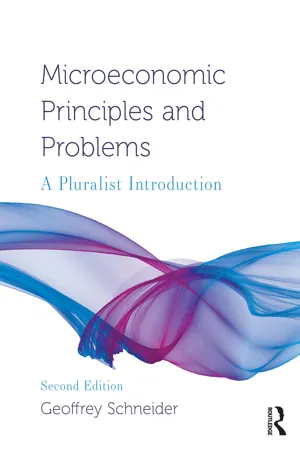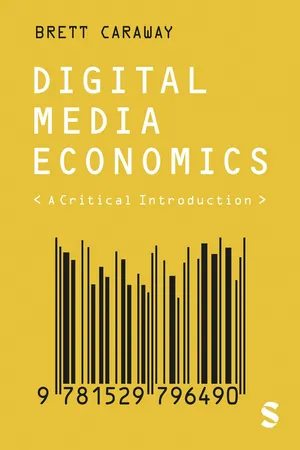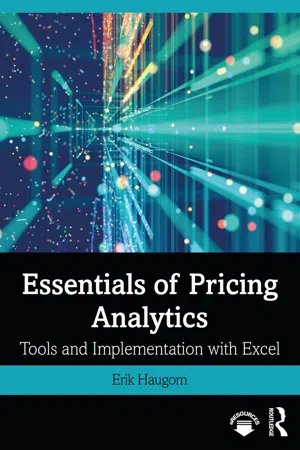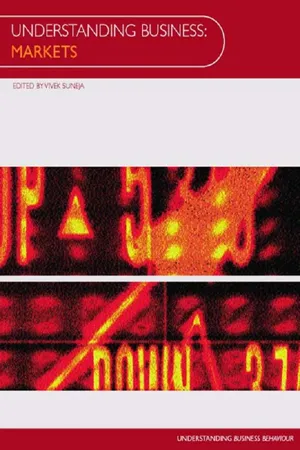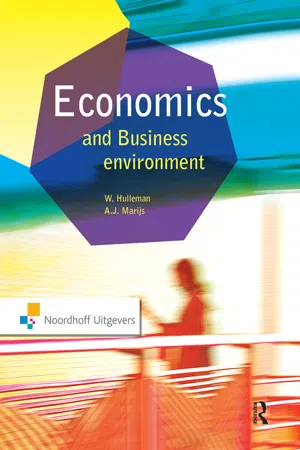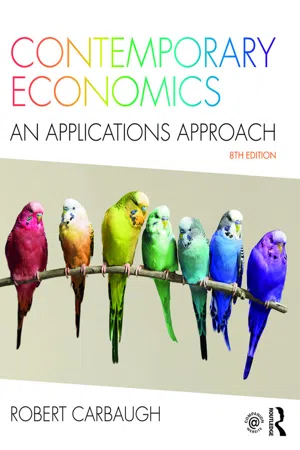Business
Point Elasticity
Point elasticity is a measure used to assess the responsiveness of quantity demanded or supplied to a change in price at a specific point on a demand or supply curve. It is calculated by taking the derivative of the demand or supply function and multiplying it by the ratio of price to quantity at the given point. This provides insight into the sensitivity of consumer or producer behavior to price changes.
Written by Perlego with AI-assistance
Related key terms
12 Key excerpts on "Point Elasticity"
- eBook - ePub
- Andrew Barkley, Paul W. Barkley(Authors)
- 2016(Publication Date)
- Routledge(Publisher)
Elasticities are unitless, and therefore attractive to social scientists who make comparisons among elasticities across all goods. The definition of price elasticity makes this clear:(9.7) Ed = (ΔQd /ΔP)*(P/Qd ).Since the price (P) and quantity demanded (Qd ) appear in the numerator and the denominator, the units of each cancel, leaving no units for an elasticity calculation. Hence, economists use elasticities rather than slopes to measure the responsiveness of consumer purchases to changes in prices and other economic variables. These unitless elasticities allow an unbiased comparison of the market responsiveness of apples and oranges.To summarize the discussion, elasticities measure how responsive consumers are to changes in price. An elastic demand curve shows that consumers are more responsive to price changes, while an inelastic demand curve reveals that consumers are not so likely to change their buying habits in response to price changes. The elasticities are comparable across all goods. The major determinant of the elasticity of demand is the availability of substitutes. If substitutes are available, then, when the price of a good increases, consumers switch to the lower-priced product.The price elasticity of demand explains many market-related situations. For example, gasoline stations in college towns often charge higher prices for gasoline the day before the beginning of Spring Break. On this day, when several thousand students are preparing to leave town, the demand for gasoline is relatively inelastic: many of the students will fill their cars’ tanks. Station owners know this and increase the price of fuel to take advantage of the fact that the students will pay higher prices in order to fulfill their vacation plans.Veterinarians often charge higher prices for rich people with poodles than for poor people with mixed breed mutts. Why? Because wealthier people are more likely to be willing and able to pay higher prices for vet services than poor people are. The elasticity of demand for medical services is lower (more inelastic) for rich persons than for poor. - eBook - ePub
- Rob Dransfield(Author)
- 2013(Publication Date)
- Routledge(Publisher)
Price elasticity of demand – measures the percentage change in quantity demanded caused by a percentage change in price. As such, it measures the extent of movement along the demand curve.Price elasticity of supply – measures how the amount of a good firms wish to supply changes in response to a change in price. Price elasticity of supply captures the extent of movement along the supply curve.In the analysis that follows we will first review elasticity of demand before going on to examine elasticity of supply. Business managers are particularly interested in the extent to which demand is likely to respond to a price change. Measuring the response is referred to as the measurement of price elasticity. In addition, it is helpful to measure the responsiveness of demand to variables other than price – for example:- The responsiveness of demand for a good to changes in the prices of other goods – referred to by economists as cross-price elasticity.
- The responsiveness of demand for a good to changes in income – referred to by economists as income elasticity.
A restaurant owner who is considering increasing prices will first want to know what teffect this will have on the customers. Will there be no effect, a small fall in customers, or a large fall? If the number of customers remains the same or falls by a smaller percentage than the price change, the business will make more revenue. The calculation used to estimate this effect is price elasticity of demand, which measures how quantity demanded for a product responds to a change in its price. Anyone wishing to raise or lower prices should first estimate the price elasticity.Measuring price elasticity Key TermPrice elasticity - eBook - ePub
Microeconomic Principles and Problems
A Pluralist Introduction
- Geoffrey Schneider(Author)
- 2024(Publication Date)
- Routledge(Publisher)
Now that we have described how price floors, price ceilings, excise taxes, and per-unit subsidies affect the supply and demand model, we need to explore the topic of elasticity in more detail. Elasticity is an extremely useful concept for both consumers and producers to understand. It is particularly important for business owners trying to understand their consumer base and how they will respond to different pricing strategies.10.5 THE PRICE ELASTICITY OF DEMAND
Price elasticity of demand refers to the responsiveness of quantity demanded to changes in price. In mathematical terms, the price elasticity of demand, eD , is equal to the percentage change in the quantity demanded divided by the percentage change in price. The price elasticity of demand is less than or equal to zero, eD ≤ 0, because of the negative slope of the demand curve. In mathematical terms, the price elasticity of demand (eD ) can be written as follows:2e D==% ▵Q D% ▵ P=▵ QQ 1▵ PP 1(Q 2−Q 1)Q 1(P 2−P 1)P 110.5.1 Price inelastic demand
In general, a demand curve is said to be price inelastic if a change in price causes very little change in the quantity demanded. Inelastic demand curves tend to be steep. Notice that in the equation for the price elasticity of demand, if the percentage change in quantity is very small compared to the percentage change in price, we will get a fraction for eD because the numerator will be smaller than the denominator in absolute value. We use the absolute value to compare the magnitude of the change in price and the change in quantity demanded because one of the numbers will be negative given the negative slope of the demand curve. So, when the demand curve is price inelastic, the absolute value of the price elasticity of demand is between 0 and 1: 0 < |eD - Peter Davis, Eliana Garcés(Authors)
- 2009(Publication Date)
- Princeton University Press(Publisher)
15,000 cars would be at most 1,000. On the other hand, the same total income divided more equally could certainly generate sales of more than 1,000. (For recent work, see, for example, Lewbel (2003) and references therein.)1.1.2 Demand Elasticities
Elasticities in general, and demand elasticities in particular, turn out to be very important for lots of areas of competition policy. The reason is that the “price elasticity of demand” provides us with a unit-free measure of the consumer demand response to a price increase.7 The way in which demand changes when prices go up will evidently be important for firms when setting prices to maximize profits and that fact makes demand elasticities an essential part of, for example, merger simulation models.1.1.2.1 Definition
The most useful measurement of the consumer sensitivity to changes in prices is the “own-price” elasticity of demand. As the name suggests, the own-price elasticity of demand measures the sensitivity of demand to a change in the good’s own-price and is defined asThe demand elasticity expresses the percentage change in quantity that results from a 1% change in prices. Alfred Marshall introduced elasticities to economics and noted that one of their great properties is that they are unit free, unlike prices which are measured in currency (e.g., euros per unit) and quantities (sales volumes) which are measured in a unit of quantity per period, e.g., kilograms per year. In our example in figure 1.1 the demand elasticity for a price increase of 10 leading to a quantity decrease of 5 from the baseline position, where P = 60 and Q = 20, isηjj= (−5/20)/(10/60) = −1.5.For very small variations in prices, the demand elasticity can be expressed by using the slope of the demand curve times the ratio of prices to quantities. A mathematical result establishes that this can also be written as the derivative with respect to the logarithm of price of the log transformation of demand curve:- eBook - ePub
Digital Media Economics
A Critical Introduction
- Brett Caraway(Author)
- 2023(Publication Date)
- SAGE Publications Ltd(Publisher)
elasticity to refer to the relationship between quantity (whether demanded or supplied) on the one hand, and changes in price or income on the other. Changes in price can elicit both strong and weak reactions from market actors, and anything in between. The price elasticity of demand refers to the responsiveness of consumers to changes in price. Alfred Marshall (1997 [1890]) is often credited with introducing the concept:And as with the demand of one person so with that of a whole market. And we may say generally:—The elasticity (or responsiveness) of demand in a market is great or small according as the amount demanded increases much or little for a given fall in price, and diminishes much or little for a given rise in price. (p. 102)In other words, demand for a particular product is elastic if a given percentage change in price causes an even greater percentage change in the quantity demanded. One might expect to find the demand for products with plenty of available substitutes to be fairly elastic. For example, a given percentage increase in the price of branded flour might result in a greater percentage decrease in quantity demanded as consumers switch to generic flour. Conversely, demand is considered inelastic when a given percentage change in price causes a smaller percentage change in quantity demanded. For example, one might expect to find the demand for a medical necessity like insulin to be fairly inelastic—after all, diabetics need insulin to survive and have a strong incentive to pay higher prices. To better understand the price elasticity of demand, consider Figures 5.0 and 5.1.Description Figure 5.0Description Figure 5.1Figure 5.0 depicts what happens when the firm Cheapo Laptops increases the price of their laptop computers. Starting at an initial price of $200 per laptop at point b and moving along the demand curve D1 to the new price of $400 at point a, we see that although Cheapo Laptops will receive an extra $200 per sale, the firm will also lose 350 customers (500 – 150). To see if the firm would benefit from raising its prices, we compare the total revenue (TR = P * Q) at points a and b. At the initial price, total revenue is equal to $100,000 (TR1 = 200 * 500). At the new price, total revenue is equal to $60,000 (TR2 = 400 * 150). By comparing total revenue in each instance, we see that the revenue gains from a higher price are offset by the loss in the number of sales (Q). Because the percentage increase in price causes a larger percentage drop in quantity, the relationship is elastic. In other words, their customers are very sensitive to changes in price. Clearly Cheapo Laptops should not double its prices—doing so would cause them to lose money. Figure 5.1 depicts what happens when Cheapo Laptops increases its prices when confronting a different demand curve—this one with a steeper slope. Moving along the demand curve D2 from the initial price of $200 at point b to a new price of $400 at point a, we see once again that the price increase causes the firm to lose customers, although this time not as many. Total revenue at the initial price is $50,000 (TR1 = 200 * 250) while total revenue at the new price is $60,000 (TR2 - eBook - ePub
Economics of Tourism and Hospitality
A Micro Approach
- Yong Chen(Author)
- 2021(Publication Date)
- Routledge(Publisher)
2 , the quantity demanded will increase disproportionately less than the decrease in price because the lower half of the demand curve is increasingly inelastic, and hence total revenue also falls.Figure 5.9 Price elasticity of demand and firm revenueFigure 5.9 shows that the curve of total revenue function (5.16) is a downward-opening parabola (a < 0). Thus, as the quantity demanded increases from zero, total revenue first increases until it reaches the vertex at which the demand becomes unit elastic, and then decreases as the quantity demanded continues to increase. As long as the price elasticity of demand is greater than 1, that is, the demand is elastic, the firm can continuously lower price to sell a disproportionately larger quantity, thus increasing revenue. As long as the price elasticity is smaller than 1, that is, the demand is inelastic, the firm can raise price which is associated with a disproportionately smaller decrease in quantity, thus also increasing revenue. Only when the percentage change in quantity demanded is equal to the percentage change in price, namely that demand is unit elastic, can total revenue be maximized. As far as linear demand is concerned, total revenue is maximized at the midpoint of the demand curve:R = p q =(5.18)b 2(= −)− b2 ab 24 a.Summary
- The responsiveness of demand can be assessed using marginal demand and demand elasticity. Marginal demand is the change in the quantity demanded of a good divided by the change in a demand determinant. Elasticity of demand is the percentage change in the quantity demanded divided by the percentage change in the demand determinant.
- Elasticity of demand is a unit-free measure of demand responsiveness, because the calculation of percentage changes cancels out measurement units. Elasticity of demand can be calculated in three ways: arc elasticity, midPoint Elasticity, and Point Elasticity.
- eBook - ePub
Essentials of Pricing Analytics
Tools and Implementation with Excel
- Erik Haugom(Author)
- 2020(Publication Date)
- Routledge(Publisher)
elastic (right panel) demand curves, as usually presented in microeconomic texts. In this case, price is a function of demanded quantity. Both ways of illustrating the price elasticity of demand induce the same conclusion, though. For a price change of a given magnitude, the change in demand will be (relatively) high if demand is elastic and (relatively) low if demand is inelastic.Figure 5.2 Illustration of inelastic (left panel) and elastic (right panel) demand. In the upper panel demand is used on the Y-axis (as commonly done in price–response functions). The lower panel illustrates inelastic and elastic demand with price on the Y-axis (as commonly done in the economics literature).We now understand that the price elasticity of demand is determined by the steepness of the price–response function. This statement is a little too general, though. The reason is that for most functional forms of price–response functions, the estimate of the price elasticity will depend on what part of the curve we choose to use to calculate an elasticity estimate. To see this, consider the following expression that can be used to estimate the price elasticity of demand:ε =(5.2)(/ dd)(− dp 2)(p 1)(p 1)(/)p 2−p 1p 1This measure is known as the Point Elasticity of demand , although it requires two combinations of prices and quantities. This estimate will depend on both the old price(and the new pricep 1)(, and where we are on the price–response function (the general level of demand at the two prices). An example is given below.p 2)Example 5.1: Calculation of price elasticity of demand for a specific product.A company increased the price of one of its products from $59 to $64. As a result, the sales went down from 12,000 units to 11,300 units. What is the Point Elasticity in this case? - eBook - ePub
Understanding Business: Markets
A Multidimensional Approach to the Market Economy
- Vivek Suneja, Vivek Suneja(Authors)
- 2005(Publication Date)
- Routledge(Publisher)
However, diagrams can be misleading, because, for example, the slope depends on the scale of the axes used in the diagram [...]. An alternative is to calculate elasticity mathematically.Measurement of price elasticity of demand
Price elasticity of demand can be measured through using the formula:or, using symbols: where:ΔQ = change in quantity;Q = original quantity;ΔP = change in price; andP = original price.If the value for price elasticity is greater than one, then demand is said to be price elastic, while if the value is less than one, demand is said to be price inelastic. The higher the value of price elasticity, the more elastic demand is said to be. Note that as there is an inverse relationship between price and the quantity demanded, the value for price elasticity of demand will be negative. However, for brevity the minus sign is often omitted.Consider the following examples. A firm raises the price of its product from £2 to £2.20 and as a result, sales fall from 400 per week to 320. What is the price elasticity of demand? Using the formula:price elasticity of demand: = (-)2 Thus demand is elastic over this price range. However, when the firm raises the price of another product, from £1 to £1.10, sales fall from 1,000 per week to 960 per week. In this case, the price elasticity of demand: = (-)0.4 In this case demand is price inelastic.Figure 4.3 Zero elasticityIf price elasticity of demand has a value of one, then demand is said to have unit elasticity. (A demand curve of unit elasticity is illustrated in Figure 4.8 .) The two extreme cases are where the price elasticity of demand is equal to zero (perfectly inelastic) or is equal to infinity (perfectly elastic). These are illustrated in Figures 4.3 and 4.4 ).Figure 4.4 Infinite elasticityFactors influencing price elasticity of demand
There are several factors which may determine the price elasticity of demand of a product. The availability of substitutes - eBook - ePub
- A. Marijs, W. Hulleman(Authors)
- 2019(Publication Date)
- Routledge(Publisher)
Figure 2.3 .Figure 2.3 Demand curves with different slopesCurve a in Figure 2.3 is a steep curve. If the price is changed by Δp the change in quantity is small. The curve is inelastic in the relevant part of the curve.Curve b has a greater elasticity than curve a . A change in price by Δp causes a greater change in quantity than in curve a .Curve c is very flat. A price change of Δp results in a very great change in quantity. Curve c is very elastic in the relevant part of the curve.Basic goods Luxury goodsThe price elasticity of the demand for basic goods is much smaller than that for luxury goods. When they are satisfying basic needs, consumers cannot react to price rises by stopping demand. Foodstuffs such as potatoes can show a very big fluctuation in price without any real change in demand. On the other hand, the sale of luxury goods such as cars is much more sensitive to price changes. It is easy for consumers to adjust their pattern of consumption when luxury items go up in price.Elastic and inelastic demand may very well occur on the one market. Industries very often consist of a few very large enterprises and many small ones. If small companies raise their prices the customers will look for other suppliers and they will lose their market. Their demand curve is elastic. Large companies can sometimes raise prices without their customers looking for other suppliers. They control such a large part of the market that customers do not have an alternative. If they were to move to a competitor then that competitor would in turn see fit to raise prices. This is one of the reasons why companies try to increase their share of the market.Price elasticity of demand is important for turnover. Entrepreneurs can use price elasticity to determine the effects of a price change on turnover (the product of price and quantity). Entrepreneurs dealing with an inelastic demand will see their turnover increase with a price rise. A price rise of 1% that is accompanied by a drop in sales of less than 1% will result in a rise in turnover. The increase in turnover is roughly equivalent to the sum of the changes in price and quantity. - eBook - ePub
Microeconomics
A Global Text
- Judy Whitehead(Author)
- 2014(Publication Date)
- Routledge(Publisher)
P = 1 in absolute terms), the percentage change in the quantity demanded is exactly equal to the percentage change in price but in the opposite direction. Consequently, if price is reduced by a certain proportion (say 10 per cent), the quantity demanded is increased by the same proportion (10 per cent) and similarly for a price decrease. Consequently, neither a price increase nor a price decrease would affect the total expenditure on the product and so the seller’s revenue from the sale of the product remains unchanged with a change in price.The value of the price elasticity of demand depends on:- The availability of substitutes . Demand for a commodity is more price elastic where there are close substitutes.
- The extent to which the commodities may be characterized as luxuries or necessities . Luxury goods are more price elastic whereas necessities are more inelastic.
- Time period . Demand is more price elastic in the long-run than in the short-run.
- Alternative uses . The more alternative uses a commodity has, the greater the price elasticity of demand.
- The proportion of total income spent on the product . The greater the proportion the higher the elasticity.
Arc elasticity of demand
The above measures of price elasticity of demand refer to what may be called the Point Elasticity of demand. This is appropriate for small changes in price. For larger changes in price, the formula for arc price elasticity of demand is used. This may be expressed (with the subscript x omitted) as:3.2.2 The PCC and the price elasticity of demandPrice elasticity of demand may be determined from the shape of the price consumption curve (PCC ). As explained in Chapter 2 , the price consumption curve is the line joining successive equilibrium points as the price of good x falls. The price elasticity of demand can be derived from the price consumption curve using money and one good (x - Available until 20 Jul |Learn more
Contemporary Economics
An Applications Approach
- Robert Carbaugh(Author)
- 2016(Publication Date)
- Routledge(Publisher)
This is because price and quantity demanded are inversely related according to the law of demand. In our example, the increase in ticket prices causes the numerator in the formula to be positive (+10 percent), while the decrease in game attendance causes the denominator to be negative (−5 percent). As a result, E d will have a negative value. By convention, economists drop the negative sign when calculating the price elasticity of demand, realizing that price and quantity demanded move in opposite directions. Depending on the response of buyers to a change in price, demand is characterized as elastic, inelastic, or unit elastic. Elastic. Demand is elastic when the percentage change in quantity demanded is greater than the percentage change in price, meaning that E d is greater than 1. Example: A 20-percent reduction in the price of Pepsi causes a 30-percent increase in the quantity demanded. Specifically, E d is 1.5 in this case (30 / 20 = 1.5). Inelastic. Demand is inelastic when the percentage change in quantity demanded is less than the percentage change in price, meaning that E d is less than 1. Example: A 30-percent increase in the price of Levi’s jeans causes a 10-percent decrease in quantity demanded. Specifically, E d is 0.33 in this case (10 / 30 = 0.33). Unit elastic. Demand is unit elastic when the percentage change in quantity demanded equals the percentage change in price, meaning that E d equals 1.0. Example: An 8-percent decrease in the price of Timex watches causes an 8-percent increase in the quantity demanded (8 / 8 = 1.0). Table 3.1 reports the estimated price elasticities of demand for selected products. When making such estimates, economists distinguish between a period during which consumers have little time to adjust (the short run) and periods during which consumers have time to fully adjust to a price change (the long run) - eBook - ePub
- Wim Hulleman, Ad Marijs(Authors)
- 2021(Publication Date)
- Routledge(Publisher)
Elastic and inelastic demand may very well occur on the one market. Industries very often consist of a few very large enterprises and many small ones. If small companies raise their prices the customers will look for other suppliers and they will lose their market. Their demand curve is elastic. Large companies can sometimes raise prices without their customers looking for other suppliers. They control such a large part of the market that customers do not have an alternative. If they were to move to a competitor then that competitor would in turn see fit to raise prices. This is one of the reasons why companies try to increase their share of the market.Price elasticity of demand is important for turnover. Entrepreneurs can use price elasticity to determine the effects of a price change on turnover (the product of price and quantity). Entrepreneurs dealing with an inelastic demand will see their turnover increase with a price rise. A price rise of 1% that is accompanied by a drop in sales of less than 1% will result in a rise in turnover. The increase in turnover is roughly equivalent to the sum of the changes in price and quantity.In the elastic part of the curve, entrepreneurs can generate greater turnover by lowering the price.EXAMPLE 2.1At a price of 100, the quantity (according to equation [1]) is 400. The turnover is therefore 40 000. A price rise of 1% results in a drop in sales of 0.5%. The turnover increases from 40 000 to 40 198 (101 x 398). The turnover has risen by about 0.5% by a price rise of 1% and a sales drop of 0.5%.TEST 2.8What will the change in turnover be if a price of 250 drops by 1%? Use equation [1].Table 2.3 describes the relationship between the price elasticity of demand and turnover.TABLE 2.3The relationship between price elasticity of demand and turnoverDemand elasticity Price Turnover −1 < Epq < 0 (inelastic demand) increase increase Epq < −1 (elastic demand) increase decrease A shift along and a shift of the demand curve
PositionChanges in the quantity demanded that are the result of a change in prices can be read from the demand curve. This is referred to as a shift along the curve. From equation [1], it is easily deduced that a price rise from 100 to 101 will result in a quantity change from 400 to 398. However, the demand curve can change position as well: for example, because the needs have changed. If the need for a product increases, customers are prepared to buy a larger quantity at the same price. During a heatwave, the demand for soft drinks will increase, even though the price remains the same. In the graph, this is indicated by a shift to the right of the curve. The demand function also changes. Because of the increasing need for a product the demand will increase at every price level. If at every price the demand increases by 50, equation [1] becomes:
Learn about this page
Index pages curate the most relevant extracts from our library of academic textbooks. They’ve been created using an in-house natural language model (NLM), each adding context and meaning to key research topics.


